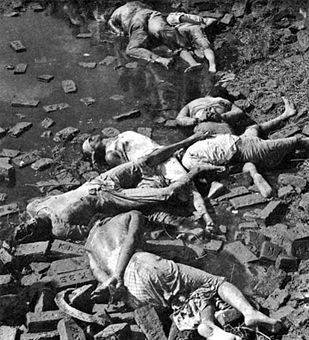
Dead bodies of Bangladeshi intellectuals.
In between March 25, 1971 and December 16, 1971—almost 9 months—approximately three million Bangladeshis were killed, 200,000 Bangladeshi women were raped, and millions of Bangladeshis were forced to flee. This 9-month period was the 1971 Bangladesh Genocide, the sixth worst genocide of the 20th century, and possibly the most forgotten. Like the Holocaust, the number of people killed during the genocide is heavily contested, which is why Bangladesh’s genocide is mistakenly cited as having 300,000 deaths. At this time, Pakistan was called West Pakistan, and Bangladesh was called East Pakistan.
The genocide was launched on March 25, 1971, and it was called “Operation Searchlight”. Its purpose was to put an end to the Bengali nationalist movement. According to Robert Payne’s book, Massacre, West Pakistani president, Yahya Khan, said: “Kill three million of them and the rest will eat out of our hands” in February 1971. Three days into the genocide (March 28), West Pakistani forces had already killed 15,000 Bengalis. The number grew to 300,000 by August 1971.
West Pakistani forces targeted young, able-bodied males during the “first phase” of the genocide. In his book Death by Government, R.J. Rummel describes how East Pakistani men were killed by West Pakistani soldiers: "In what became province-wide acts of genocide, Hindus were sought out and killed on the spot. As a matter of course, soldiers would check males for the obligated circumcision among Moslems. If circumcised, they might live; if not, sure death."
Susan Brownmiller wrote a book, Against Our Will, chronicling the atrocities of 1971. In the book, she documented the rape and sexual abuse of East Pakistani women: "Rape in Bangladesh had hardly been restricted to beauty…Girls of eight and grandmothers of seventy-five had been sexually assaulted ... Pakistani soldiers had not only violated Bengali women on the spot; they abducted tens of hundreds and held them by force in their military barracks for nightly use." A common form of assault was gang raping newlywed brides.
Many journalists were imprisoned so that the horrific practices of West Pakistani soldiers and officers would not be exposed. Many East Pakistani intellectuals and academics, especially those working at Dhaka University, were killed in an attempt to keep them out of the nationalist movement. Several hundred Bengalis were killed on this day alone.
The extent of damage to which West Pakistan reached was contested directly after ending the genocide because many bodies were not found until later. In 1999, construction workers found five whole skeletons and almost 2,000 bones. Upon excavating an old pump house in another city, 70 skeletons and over 5,000 bones were found. These bones and skeletons have been preserved in Bangladesh’s Liberation War Museum.
December 16, 2016 marks the 45th anniversary of the end of the 1971 genocide and the Bangladesh Liberation War. To this day, Pakistan has not issued an apology for the genocide, though they have informally acknowledged it. It is important to remember the atrocities committed against the men, women, and children of Bangladesh. This is not ancient history, nor is it a small number of people who were attacked. This happened less than 50 years ago, and it is something to remember.
